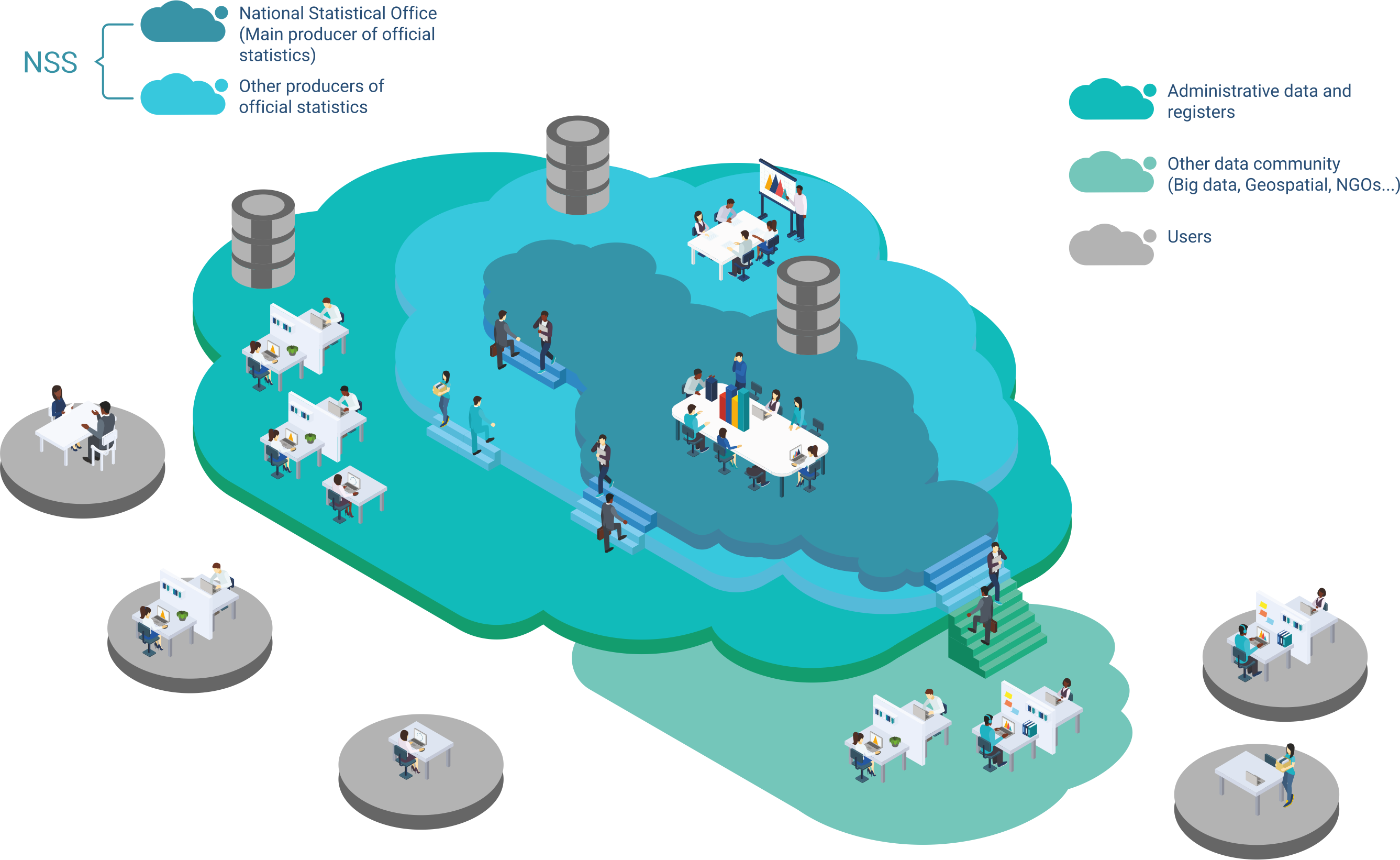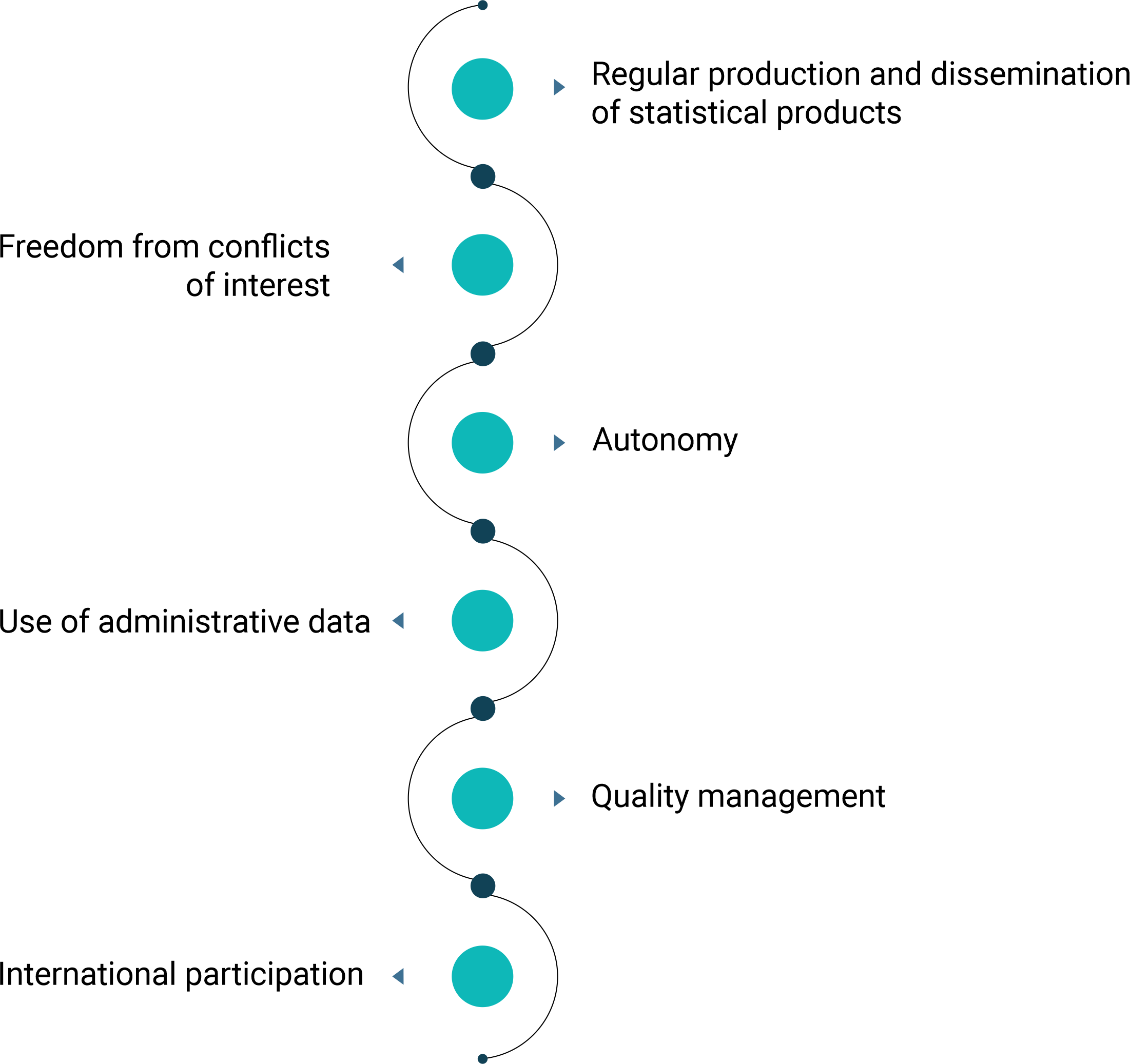4.2 Structure of the national statistical system
4.2.1 Delimitation of the national statistical system
The NSS is composed of all organizations which produce official statistics and are a part of the public administration in a country. These are:
■ the NSO as core producer;
■ other national producers. These are statistical departments1 or units of other organizations such as government departments/ministries or special agencies.2 In this handbook, the term parent body is used to designate the organization such as ministry or agency to which the statistical department or unit belongs.

Many countries lack a clear delimitation of the NSS. The NSS is often assumed to consist of those producers that are included in the annual or multi-annual statistical programmes. In some cases, there is an explicit enumeration of producers of official statistics in the statistical legislation. However, explicit criteria for being one of the other producers of official statistics and therefore being a member of the NSS are seldom defined.
The clear delimitation in terms of organizational units is recommended for the following reasons:

a.The relationship between producers of the same statistical system is part of the governance rules of the system, which may restrict the autonomy of individual producers through professional standards and procedures that are binding for the whole system, and through other prerogatives of the chief statistician (see Chapter – 4.3.3)
4.2.2 Legal frameworks, obligations, and restrictions
Any additional specific conditions need to be explicitly included in the law. The statistical legislation might have to define a process by which producers are certified (and decertified) as members of the statistical system.
The main criterion to be met by each producer of official statistics is whether it has the capability and willingness to fully and sustainably respect all UNFPOS, not least those on confidentiality and professional independence, and the other provisions of the statistical law. Other criteria include:

■ Regular production and dissemination of statistical products: This covers official statistics for which the producer is fully accountable.
■ Freedom from conflicts of interest: The statistical department in charge of the production has to be free of any conflicts of interest that may be created by parallel non-statistical tasks of the parent body, such as administrative decisions concerning individual persons or businesses or the maintenance of administrative registers. Combining simultaneous responsibility for such non-statistical activities and official statistics activities in a statistical department can undermine the commitment to use data exclusively for statistical purposes. A statistical department acting as producer of official statistics should not be seen as part of the policy-making branch of the parent body as this can undermine the credibility of impartiality. Neither should it act and be considered as part of the monitoring activities of the parent body. However, a producer of official statistics can carry out a limited range of statistical activities that do not qualify as official statistics because of their experimental, scenario-based, or internal nature3.
■ Autonomy: For its official statistics activities, the statistical department has to be autonomous from the rest of the parent body in terms of choice of methods, definitions and in the timing and content of all forms of dissemination (see Chapter 4.2.1 – Delimitation of the national statistical system), and this has to be accepted by the senior managers of the parent body.
■ Use of administrative data: The statistical department should have the knowledge and the authority to make the necessary adaptations to data collected by the parent body for administrative purposes in order to render them as close as possible to concepts, definitions, and target universes of official statistics. This may involve:
• estimating missing elements and eliminating statistical units that are not relevant from a statistical point of view;
• combinations with other data sources;
• using editing and imputation methods;
The results disseminated as official statistics are therefore in most cases different from a simple counting or adding up of the records of the original administrative transactions.
■ Quality management: The statistical department has implemented or is willing to implement a process of quality management that is in line with the standards established for the whole statistical system (see Chapter 7 - Quality Management).
■ International participation: The statistical department has the means to participate in international activities in official statistics relevant to its domain of responsibility and to implement any new statistical standards that may emerge at the international level.
Whether the conditions above are met in practice, both by producers other than the NSO that are part of the NSS and by other organizational units that seek to become members of it, should be regularly assessed. Such an assessment should take place as part of the NSO's task of preparing a multi-annual programme. (see Chapter 4.4.1 – Annual and multi-annual statistical programmes). An NSO should also be assessed against these criteria. This may be done through regular internal audits of the various departments in turn as part of its quality management. Occasional assessments of the NSO (or the national statistical system as a whole) by the international community of official statistics may also be organized. For this purpose, this community has developed instruments such as peer reviews or global assessments (see Chapter 4.2.5 – Relationship between national and international statistical systems). Such reviews are also a valid mechanism for the occasional assessment of other national producers by the NSO.
The task of converting these administrative data into official statistics should be assigned to the NSO or another producer of official statistics. In such cases, the organization responsible for collecting and processing the administrative data has to regularly transmit the data set to the NSO or another unit within the NSS. The NSO or the responsible national producer would then take over the responsibility for transforming these data into official statistics and disseminate them as such with a clear indication of the origin of the data sources used.4
The delimitation of the NSS is also necessary as it defines the scope of how statistical legislation is applied for any data collected on the basis of other legislation than the statistical law. When such data are imported into the statistical system, they become subject to the statistical law. Depending on the national legislation, notably concerning data protection, it may be advisable to include a provision in the statistical law such as article 15.3 of the GLOS so as make any change of legal frame explicit. This is also likely to reduce conflicts between confidentiality regulations in the statistical and other laws.
In such cases, it is recommended that the law is changed and extended to all activities of official statistics irrespective of the producer. If that is not feasible, it is recommended that the NSO reaches out to the other producers, seeking to convince them to follow the provisions of the law and the UNFPOS as concerns their activities related to official statistics.
4.2.3 The position of the Central Bank
Therefore, it is important to make sure that the official statistics for which the Central Bank is responsible are subject to the same (or at least equivalent) principles as contained in the national statistical law and the UNFPOS. Similarly, the statistical department of the Central Bank needs to be professionally independent of the top management of the Bank and a part of the NSS. Some countries have assigned the responsibility for producing the national accounts to the Central Bank. However, for such a widely accepted and powerful analytic system for economic, social, and demographic statistics, this is not a recommended practice (see Chapter 9 - Analysis and Analytical Frameworks).
It is recommended to explicitly mention the Central Bank in the statistical law, and not only in a lower-level legal act or in the statistical programme for statistical departments of ministries. The reason is that the Central Bank law normally states that it is independent of the government, which in some countries is interpreted as making it impossible for the statistical department of the Central Bank to be part of a national statistical system and to be bound by the provisions in law other than the Central Bank law.
An explicit statement in the statistical law can open up the possibility of including the statistical department of the Central Bank in the NSS and ensure that its activities on official statistics are in accordance with the UNFPOS. In this way, the official statistical activities of the Central Bank will be subject to the NSS-wide standards and to other provisions on coordinating official statistics. As an important user of official statistics, it will also ensure that the Central Bank has access to data that are available for statistical purposes within the NSS (see Chapter 4.5.5 – User access to confidential data for their own statistical purposes).
4.2.4 Relationship between national and sub-national statistical systems
One of the conditions for qualifying as national statistical system is a common legal base. For national systems, this common legal basis is the statistical law at national level, but countries differ in the status of sub-national statistical offices and their coverage by the national statistical law.
Sub-national statistical offices as units of the NSO
Some NSOs have regional offices with identical functions throughout the territory of the country, sometimes at more than one layer. Many small countries do not have regional offices but operate from a single location, usually, the capital. Other countries have a few offices in other places than the headquarters, but with responsibilities for certain nation-wide activities assigned to them In some countries, the statistical law requires the NSO to set up regional offices, but that may be it is essential that such statistical sub-offices have only one line of reporting, that being to the headquarters of the NSO, and do not have a second line of reporting to a senior administrator of the local or regional entity (as used to be the case in some countries with centrally planned economies).
Organizational models in federal countries and countries with regions that have a special status
A comprehensive NSS can be set up in federally organized countries if the federal and state level agree that an NSS should meet the information needs also of state administrations.5 The statistical law would then not only be a federal statistical law but a true national statistical law. The same holds for the NSO in terms of its mandate, although in most cases it will remain a part of the federal executive structure and mainly financed by the federal budget. In such cases, the role of the states in the governance of the NSS will have to be clearly spelt out in the statistical law. If the federal and state level can agree to such a solution, and if it is constitutionally possible, this can be an efficient set-up, independent of the number of states. However, it implies a high degree of functional centralisation in the NSO. Such an NSO may have, as part of its internal organization, regional offices or branches.
In some federal countries, such a national solution for official statistics would be possible only if it were explicitly foreseen in the constitution, which is not always the case. Otherwise, states either have to be satisfied with what is produced by the federal statistical system or if not, create the necessary legal basis for additional statistical activities they would like to carry out at their territorial level, including the possibility of organizing their own data collection for statistical purposes. In this case, there will be a statistical law at the federal level and parallel statistical laws for some or all states, which will normally designate a single producer of official statistics (or at the maximum a sub-national statistical office6 plus a very limited number of other producers of official statistics in the sub-national administration), thus forming a parallel statistical system at the sub-national level.7
Therefore, such sub-national offices are simultaneously members of the NSS and of the sub-national statistical system, which institutionally and legally is a rather complex set-up8. Sub-national statistical offices at the level of an autonomous region are therefore the third type of members of the NSS, in addition to the NSO and other national producers. To avoid substantive problems from this dual role, it is essential that the provisions in the two statistical laws are as identical as possible, notably on the issue of confidentiality and exchange of confidential data within both systems.
As members of the NSS, sub-national statistical offices must fulfil the criteria (see Chapter 4.2.2 – Legal frameworks, obligations, and restrictions) applying to other national producers, with the possible exception of the ability to participate in international activities of official statistics. Since they tend to be relatively small units, sub-national statistical offices may face the same problem of a credible organization-internal borderline at a relatively low organizational level as statistical departments of other national producers. The statistical law at national level should include explicit provisions about the possibility that the state level is charged with carrying out parts of official statistics activities that are part of the federal statistical programme and how they are involved in the process of preparing such programmes at the federal level (see Chapter 4.4.2 – Types of statistical programmes).
Finally, it would be desirable to use the same criteria to periodically assess the institutional quality of each sub-national statistical office from time to time that are applied for the assessment of other national producers when their inclusion in the statistical programme is discussed.
4.2.5 Relationship between national and international statistical systems
NSOs and possibly other producers at the national level with international statistical responsibilities, can be members of a multi-national or international statistical system and be responsible for applying the relevant rules and procedures of these.
In a supra-national set-up such as the European Union, a common legal basis has been established, containing statistics-specific rules of common approaches, procedures, methods and definitions, as well as on governance and decision-making. Such a system includes a statistical office as the only producer of official statistics at the supra-national level, the NSOs of all member countries, and possibly additional national producers responsible for producing official statistics relevant to the supra-national system.
In practice, the term ‘international statistical system’ is not precisely defined. It may apply to the statistical department(s) of an international organization plus the NSOs (and the relevant other national producers) of the member countries of a given organization. Or it may refer to the sum of various statistical departments of an international organization but without producers from member countries.
However, these principles have not been translated into legally enshrined institutional arrangements specific for international statistical activities in such a way that professional independence of statistical departments within their parent international organizations is protected, or that a distinction between official and other statistical products are made. The above-mentioned UN quality assurance framework requires that statistics disseminated by international organizations, based on statistics provided by member countries, are checked for consistency with international standards by the responsible international statistical department, in order to ensure a sufficient degree of international comparability. Only in this case can such a department be considered a producer of international official statistics. Where the quality of national statistics is uncertain or clearly inadequate, the relevant international statistical department would either have to disregard them or, in consultation with the national producer, adjust them to make them comparable internationally and over time. If made available to users as part of international statistics without adjustment, these products should at least be labelled appropriately.
For national producers, participation in supra- and international systems and networks is important in many respects:
■ to participate in the development and revision of international statistical standards (see Chapter 4.6.2 – Coordination through standards);
■ to organize internationally coordinated and funded major data collection activities such as the International Comparison Programme (ICP);
■ to gain a deeper understanding of the international standards and requirements in order to enhance the relevance, quality, and comparability of their own national statistics;
■ to assist countries with less developed statistical systems in improving their national statistical capacities.
Yet another type of international statistical activities merits special attention here: the periodic assessment of national statistical systems regarding their capacity to produce key official statistics in compliance with the UNFPOS or similar codes such as the European statistics Code of Practice in the European Statistical System. These activities are called peer reviews or global assessments; they are carried out by teams of official statisticians with extended work experience at national and international levels. The reviews and assessments are conducted under the auspices of international or supranational organizations and the final reports are made publicly available. Whereas the NSO periodically assesses other producers at national level for their capability and willingness to comply with the UNFPOS, international assessments are the most efficient way to ensure that NSOs are periodically examined against the same criteria. In the UN context, it is up to a country to request such assessments; they are a necessary input into developing a strategic plan and attracting funds from donors for this development. In a supra-national context like the EU, all member countries are subject to such assessments periodically.




